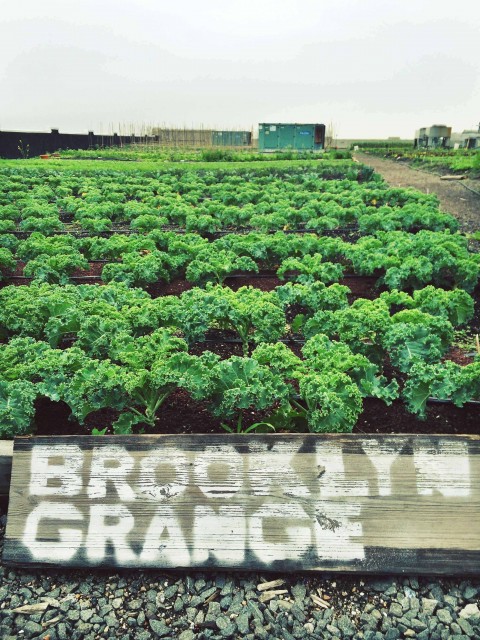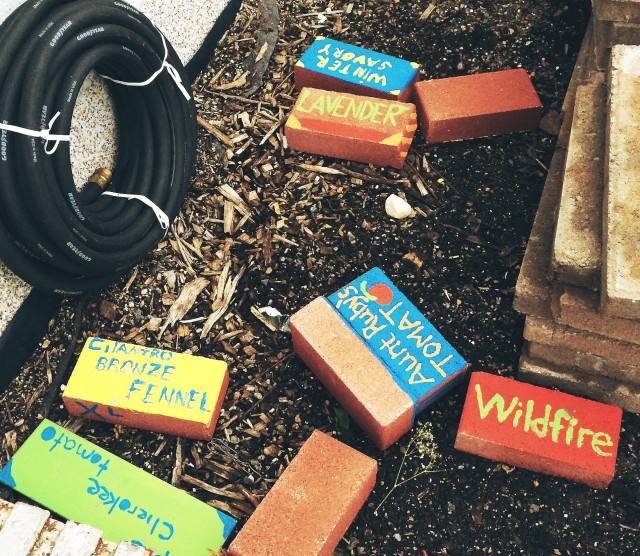
The scent of warm coffee welcomed me as I stepped into COFFEED beneath Brooklyn Grange. The café’s interior was decorated with burlap sacks nestled over aged wood furniture, evidence of fair trade imports and artfully brewed beverages. People sat coupled in intimate conversation, while a large stuffed bear smiled out from a corner, as though I was returning to some place like home.
COFFEED is known for its coffee bought directly from family farms in Burundi, Columbia, Panama, and Ethiopia. Much of its food is locally grown at Brooklyn Grange, and all organic waste is composted daily, while 5-10 percent of COFFEED’s revenue is given back to the Queens community through charities in New York.


Environmentalists of all kinds were gathered for a movie screening of In Transition 2.0. There were construction managers, farmers, teachers, and curious New Yorkers who had come by for quality coffee and conversation, which ranged from permaculture to personal endeavors to aboriginal lifestyles.
The movie is the second documentary covering the rising transition movement in which local communities—neighborhoods, blocks, or small towns—band together on a grassroots level to prepare for the challenges of climate change and economic crisis. Rather than leave change to politicians, individuals across the globe are now taking it upon themselves to organize and create systems such as farms, local electricity, and local markets.
‘Transition’ includes several stages: Raising awareness, Deepening, Connecting, and Building. The process begins with rallying people together, then the group brainstorms projects based on the community’s unique resources and demands. In Bolton, UK, the transition town located on a large hill plans to use simple rope technology and gravity to transport large shipments down to their homes—a process completely unique to their community, but utterly ingenious.
[pullquote align=”right”]Local food products are often one of the first steps in a transition project[/pullquote]The last step of transition culture is to make sustainable ideas reality. A group in Deventer, Netherlands is setting up Repair Cafés, free meeting places where people repair their things together and help others who don’t know how. Because of a mutual pressure to make these projects work, people feel compelled to show up and be a part of the community’s success. Gathering a network of interdependent people is one of the main ways transition culture works.
Transition also includes Dreaming, Planning, Creating, and Celebrating. In Transition 2.0 stressed the importance of celebrating final products to foster community spirit. Most transition projects serve the three-fold purpose of strengthening the community, building environmental and economic resilience, and sustaining each individual’s well-being for the future.
Local food products are often one of the first things that give a transition project momentum. One local farm provides employment and community service for troublemakers; another provides a way for low-income citizens to feed themselves. The Kensal to Kilbern transition town in the UK now provides fresh weekly batches of organic foods at affordable prices through their Field to Fork Cooperative, with plans to expand to a greater ‘patchwork garden’ throughout London.
By now, most transition towns have their own websites that document their various successes, raise awareness for their citizens to participate, and provide a medium for community organizing. How else would we, across the planet, know of the efforts of a couple in Mashhad, Razavi Khorasan, Iran? Thanks to their ability to share their success with us, we are able to learn about their projects of a permaculture farm and a School of Nature.
In Transition 2.0 asks how can ordinary people withstand challenges like climate change or market failures? And transition culture answers that “It’s not about the change from all over the world, but [the change within] our own community.” Local transition can save our own communities, and if every community shares this perspective, it can save the world too.
[pullquote align=”left”]Local power systems can build resiliency into transition towns[/pullquote]Transition culture fortifies the local community when everyone puts in a little. Care for one another. Generate food and electricity ourselves. Keep the money local. “Every time we pay our energy bills,” one leader explained, “that money leaves the community.” The movie depicted this problem using a bucket analogy, in which the community is a full bucket of water, and in poured grants, wages, and currency. Suddenly holes were punched in the bucket to represent imports, bills, and energy. Then, with the help of transition culture, local food, local currency, and local power can plug the holes and allow the community bucket to remain full.
An example of local power is community solar panel grids, such as those in Transition Town Lewes in the UK. Together, their town pooled their money and raised 31,000 pounds to invest in a set of solar panels for the roof of their local brewery. The money they saved by no longer paying for electricity goes directly back to the people and boosts their local economy. Similarly, Transition Town Brixton created the Brixton pound, a form of local currency transferred through a smart phone app, which allows Brixtoners to pay local vendors and services directly, reducing the outflow of wealth from the town.
[pullquote align=”right”]Perhaps the best examples of transition culture occur naturally …because it is natural for neighbors to want to take care of one another [/pullquote]Local money is particularly important in times of disaster. Transition culture can be a powerful tool when the community is suffering, as shown in Japan after the Earthquake of 2011, where regions of the country banded together to provide relief for those who had lost everything. Before the earthquake, Transition Fujino had implemented ‘Yorozuya’, their form of local currency, and the network thrived by connecting one another and offering help with simple tasks, like connecting a vendor to a buyer. Post-earthquake, Fujino could gather and sort their relief materials efficiently because of this network, and together sought renewable energy in response to the damage done.
Perhaps the best examples of transition culture are not necessarily tied to the greater movement, but naturally occur — it is natural for neighbors to want to take care of one another. Just think of how New York banded together following Sandy, or how many organizations such as COFFEED support, and are supported by, the local community.
Transition begins with the responsibility and power of all the individuals involved. The movie introduced the concept of inner transition, the process of melding your needs and solutions with the community’s. This notion of ‘social cohesion’ is a bottom-up approach to the climate change movement.
We cannot take on climate change alone, and our communities have strengthened in response to its impending consequences. Fear, however, need not be the primary motivator of such strength. Transition culture helps us realize that strong communities improve our lifestyles beyond sustainability. Small-scale structural change also encourages those who would not ordinarily take action, because the infrastructure has been put in place by fellow citizens.
After the movie, we discussed existing models in NYC, such as bike sharing, crowd-funding, installing renewable energy to local grids, and Freecycle, the free version of Craigslist. There are already several Transition communities in and near the five boroughs, including Hastings-on-Hudson, which has been launched and remains well coordinated, as well as Brooklyn NYT Mullers, Sustainable Forest Hills, and Transition New York City, most still in the early stages. There are also strong initiatives in Marbletown, Westchester, and New Jersey.
Transition NYC began as a collaboration between many preexisting organizations, including New York City Peak Oil Meetup, Beyond Oil NYC, Neighborhood Energy Network, Sustainable Forest Hills, and Sustainable Flatbush. It remains in the early stage of Raising Awareness and Deepening, but it is kick-starting the participation of New York in the global transition movement.
Simply by bringing us all together for the screening, COFFEED created an example of transition culture while we discussed the potential strategies for strengthening New York’s resilience. Just a couple of hours together gave us a sense of greater community, and a greater will to adapt. A platform for conversation, a group of willing individuals, and comfortable café atmosphere can lead to a perfect storm for sparking creativity—and action.
Update: COFFEED has a new branch opening in Chelsea, in partnership with the charity New York Foundling.